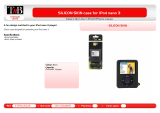
English
|
9
2 WARNING
• The unit can only be installed in a car with
a 12V DC power supply, negative ground.
• If you connect the ignition wire (red)
and the battery wire (yellow) to the car
chassis (ground), you may cause a short
circuit, that in turn may start a fire. Always
connect those wires to the power source
running through the fuse box.
¤
CAUTION
• Install this unit in the console of your
vehicle.
• Do not touch the metal part of this unit
during and shortly after the use of the
unit. Metal part such as the heat sink and
enclosure become hot.
• Mounting and wiring this product
requires skills and experience. For safety’s
sake, leave the mounting and wiring work
to professionals.
• If you experience problems during
installation, consult your Kenwood dealer.
Disconnect the battery’s negative terminal
and make all electrical connections before
installing the unit.
• Insulate unconnected wires with vinyl
tape or other similar materials. To prevent
a short circuit, do not remove the caps on
the ends of the unconnected wires or the
terminals.
• Be sure to ground this unit to the car’s
chassis again after installation.
• If the fuse blows, first make sure the wires
are not touching to cause a short circuit,
then replace the old fuse with one with
the same rating.
• When only two speakers are being
connected to the system, connect the
connectors either to both the front
output terminals or to both the rear
output terminals (do not mix front and
rear). For example, if you connect the +
connector of the left speaker to a front
output terminal, do not connect the -
connector to a rear output terminal.
• Connect the speaker wires correctly to the
terminals to which they correspond. The
unit may be damaged or fail to work if
you share the - wires or ground them to
any metal part in the car.
• Do not use your own screws. Use only
the screws provided. If you use the wrong
screws, you could damage the unit.
• If your car’s ignition does not have an ACC
position, connect the ignition wires to a
power source that can be turned on and
off with the ignition key. If you connect
the ignition wire to a power source with
a constant voltage supply, as with battery
wires, the battery may die.
• If the console has a lid, make sure to
install the unit so that the faceplate will
not hit the lid when closing and opening.
• After the unit is installed, check whether
the brake lamps, blinkers, wipers, etc. on
the car are working properly.
• Mount the unit so that the mounting
angle is 30° or less.
Before installation
B59-2069-00_00_2DIN_K_QSG.indb 9 11/01/19 16:46




















